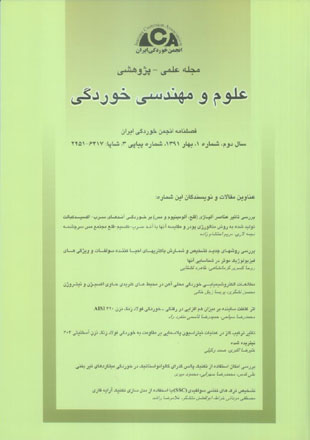فهرست مطالب

مجله علوم و مهندسی خوردگی
سال دوم شماره 1 (پیاپی 3، بهار 1391)
- تاریخ انتشار: 1391/02/02
- تعداد عناوین: 7
-
-
Page 23Sulfate reducing bacteria (SRB), are anaerobic bacteria that use sulfate as final electron acceptor and produce H2S. SRBs have great economic importance in the oil industry, where they cause severe problems, including sourting of oil and gas deposits and corrosion of production facilities. Considerable effects have been directed toward the development of rapid methods for detection and enumeration of SRB in natural and industrial environments. In general, the methods used to enumeration SRB can be divided into the following two categories. 1) direct detection methods. 2) culture methods. The direct detection methods developed recently include: 1) the use of oligonucleotide probes and PCR primer. 2) FISH method for detection and enumeration of bacteria in sediments, 3) detection and enumeration of bacteria by competitive PCR. Molecular methods are rapid and trust worthy but in the case of having enough time, culture methods are cheaper and save money. So, Studing of general features that are effective on detection of SRBs are still important.Keywords: Sulfate reducing bacteria, new methods, physiologic features
-
Page 43In this paper, effect of particle concentration on the erosion -corrosion behavior of AISI 420 stainless steel was investigated. Erosion-corrosion tests were conducted using an impingement jet apparatus containing a solution of 3.5% NaCl and 30, 60 and 90 g /lit of SiO2 particles and weight loss of samples were measured. Tafel polarization test was carried out to study the static corrosion behavior of steel samples. Scanning electron microscope was used to study the synergy between erosion and corrosion of th e alloy. The results showed that by increasing the sand concentration from 30 to 90 g/lit, erosion and erosion corrosion rates increased 73 and 153%, respectively. The results also showed that the increase of sand concentration the synergy rate between erosion and corrosion also increased.Keywords: Erosion, corrosion, Synergy rate, SiO2, Stainless steel
-
Page 63In this paper, corrosion rate of bars in concrete structures was examined using transientpotential response at corrosion intersection method by stimulating a small gavanostaticpulse. In this study, measurements on steel bars subjected to corrosion in concrete beamwere conducted under intensive corrosion conditions. Times of applying galvanic pulse arebetween 5 and 180 second and lateral distance of measuring point from the bar variesbetween 0 and 400 mm. To evaluate transient electrochemical responding results, 1 kHz sampling rate was used which allows corrosion equalization with a set of distinguishablecapacitors and resistors, despite other methods, their values are proportionate to the barcorrosion conditions. Here, first, corrosion rate is calculated through resistor elementsconnected with corrosion intersection and then it is compared to the corrosion ratedetermined using the widely used method Linear Polarization Resistance (LPR). The resultsdemonstrate that Galvanostatic pulse transient technique allows evaluation of LinearPolarization Resistance, and corrosion values gained are more reliable than LPR method.Keywords: lvanostatic, Bars Corrosion, Transient pulse, Linear Polarization Resistance
-
Page 75The importance energy from the oil and gas that has caused the behavior of the steelsused in oil and gas pipelines, especially high-strength steels, has been considered by oil-rich and industrial countries. The deployment pipelines in sour environments are more prone to corrosion, particularly destruction caused by hydrogen brittleness. The phenomenon of sulfide stress cracking (SSC) can occur when sulfide is present in the service pipe. Small dimensions and the destructive effects of this type of crack have made that detection of the hydrogen corrosion cracks is especially important. A new method for Detection of these type cracks is use of phased array ultrasonic technique. The finite element method is used for modeling the phased array technique in a two-dimensional geometry. Ultrasonic waves are generated in samples with slit and the interactions of waves with this discontinuity are monitored. Phase array tests were carried out on carbon steel blocks with slits and and a sample of the weld that have sulfide stress crack. To investigate reliability and efficacy of the proposed approach phased array numerical results are compared with the experimental results.Keywords: Sulfide corrosion, Phased array, Finite element method

